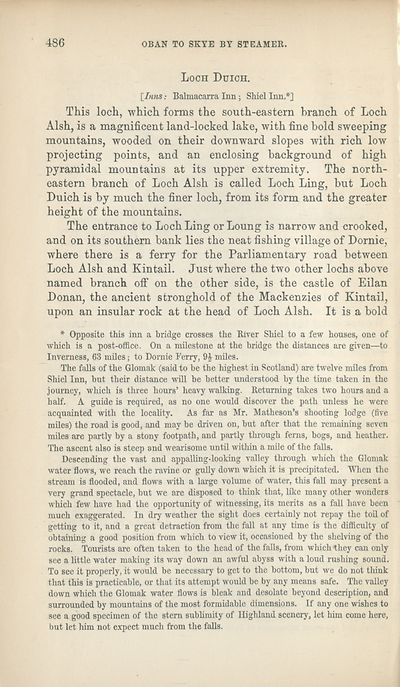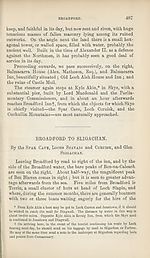Download files
Complete book:
Individual page:
Thumbnail gallery: Grid view | List view

486
OBAN TO SKYE BY STEAMER.
Loch Dcich.
[/him : Balmacarra Inn; Shiel Inn.*]
This loch, which forms the south-eastern branch of Loch
Alsh, is a magnificent land-locked lake, with fine bold sweeping
mountains, wooded on their downward slopes with rich low
projecting points, and an enclosing background of high
pyramidal mountains at its upper extremity. The north¬
eastern branch of Loch Alsh is called Loch Ling, but Loch
Duich is by much the finer loch, from its form and the greater
height of the mountains.
The entrance to Loch Ling or Loung is narrow and crooked,
and on its southern bank lies the neat fishing village of Dornie,
where there is a ferry for the Parliamentary road between
Loch Alsh and Kintail. Just where the two other lochs above
named branch off on the other side, is the castle of Eilan
Donan, the ancient stronghold of the Mackenzies of Kintail,
upon an insular rock at the head of Loch Alsh. It is a bold
* Opposite this inn a bridge crosses the River Shiel to a few houses, one of
which is a post-office. On a milestone at the bridge the distances are given—to
Inverness, 63 miles; to Domie I’erry, 9£ miles.
The falls of the Glomak (said to be the highest in Scotland) are twelve miles from
Shiel Inn, hut their distance will be better understood by the time taken in the
journey, which is three hours’ heavy walking. Returning takes two hours and a
half. A guide is required, as no one would discover the path unless he were
acquainted with the locality. As far as Mr. Matheson’s shooting lodge (five
miles) the road is good, and may be driven on, but after that the remaining seven
miles are partly by a stony footpath, and partly through ferns, bogs, and heather.
The ascent also is steep and wearisome until within a mile of the falls.
Descending the vast and appalling-looking valley through which the Glomak
water flows, we reach the ravine or gully down which it is precipitated. When the
stream is flooded, and flows with a large volume of water, this fall may present a
very grand spectacle, but we are disposed to think that, like many other wonders
which few have had the opportunity of witnessing, its merits as a fall have been
much exaggerated. In dry weather the sight does certainly not repay the toil of
getting to it, and a great detraction from the fall at any time is the difficulty of
obtaining a good position from which to view it, occasioned by the shelving of the
rocks. Tourists are often taken to the head of the falls, from which they can only
see a little water making its way down an awful abyss with a loud rushing sound.
To see it properly, it would be necessary to get to the bottom, but we do not think
that this is practicable, or that its attempt would be by any means safe. The valley
down which the Glomak water flows is bleak and desolate beyond description, and
surrounded by mountains of the most formidable dimensions. If any one wishes to
see a gbod specimen of the stern sublimity of Highland scenery, let him come here,
but let him not expect much from the falls.
OBAN TO SKYE BY STEAMER.
Loch Dcich.
[/him : Balmacarra Inn; Shiel Inn.*]
This loch, which forms the south-eastern branch of Loch
Alsh, is a magnificent land-locked lake, with fine bold sweeping
mountains, wooded on their downward slopes with rich low
projecting points, and an enclosing background of high
pyramidal mountains at its upper extremity. The north¬
eastern branch of Loch Alsh is called Loch Ling, but Loch
Duich is by much the finer loch, from its form and the greater
height of the mountains.
The entrance to Loch Ling or Loung is narrow and crooked,
and on its southern bank lies the neat fishing village of Dornie,
where there is a ferry for the Parliamentary road between
Loch Alsh and Kintail. Just where the two other lochs above
named branch off on the other side, is the castle of Eilan
Donan, the ancient stronghold of the Mackenzies of Kintail,
upon an insular rock at the head of Loch Alsh. It is a bold
* Opposite this inn a bridge crosses the River Shiel to a few houses, one of
which is a post-office. On a milestone at the bridge the distances are given—to
Inverness, 63 miles; to Domie I’erry, 9£ miles.
The falls of the Glomak (said to be the highest in Scotland) are twelve miles from
Shiel Inn, hut their distance will be better understood by the time taken in the
journey, which is three hours’ heavy walking. Returning takes two hours and a
half. A guide is required, as no one would discover the path unless he were
acquainted with the locality. As far as Mr. Matheson’s shooting lodge (five
miles) the road is good, and may be driven on, but after that the remaining seven
miles are partly by a stony footpath, and partly through ferns, bogs, and heather.
The ascent also is steep and wearisome until within a mile of the falls.
Descending the vast and appalling-looking valley through which the Glomak
water flows, we reach the ravine or gully down which it is precipitated. When the
stream is flooded, and flows with a large volume of water, this fall may present a
very grand spectacle, but we are disposed to think that, like many other wonders
which few have had the opportunity of witnessing, its merits as a fall have been
much exaggerated. In dry weather the sight does certainly not repay the toil of
getting to it, and a great detraction from the fall at any time is the difficulty of
obtaining a good position from which to view it, occasioned by the shelving of the
rocks. Tourists are often taken to the head of the falls, from which they can only
see a little water making its way down an awful abyss with a loud rushing sound.
To see it properly, it would be necessary to get to the bottom, but we do not think
that this is practicable, or that its attempt would be by any means safe. The valley
down which the Glomak water flows is bleak and desolate beyond description, and
surrounded by mountains of the most formidable dimensions. If any one wishes to
see a gbod specimen of the stern sublimity of Highland scenery, let him come here,
but let him not expect much from the falls.
Set display mode to:
![]() Universal Viewer |
Universal Viewer | ![]() Mirador |
Large image | Transcription
Mirador |
Large image | Transcription
| Antiquarian books of Scotland > Scotland/Scots > Black's picturesque tourist of Scotland > (610) |
|---|
| Permanent URL | https://digital.nls.uk/130035510 |
|---|
| Description | Thousands of printed books from the Antiquarian Books of Scotland collection which dates from 1641 to the 1980s. The collection consists of 14,800 books which were published in Scotland or have a Scottish connection, e.g. through the author, printer or owner. Subjects covered include sport, education, diseases, adventure, occupations, Jacobites, politics and religion. Among the 29 languages represented are English, Gaelic, Italian, French, Russian and Swedish. |
|---|

